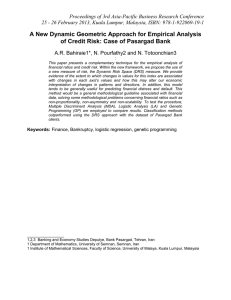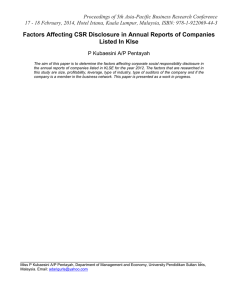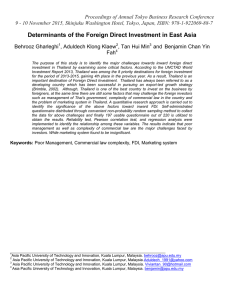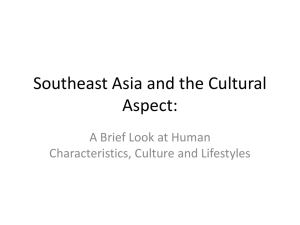"STUDENTIFICATION" IS IT A KEY FACTOR WITHIN THE RESIDENTIAL DECISION-MAKING PROCESS
advertisement
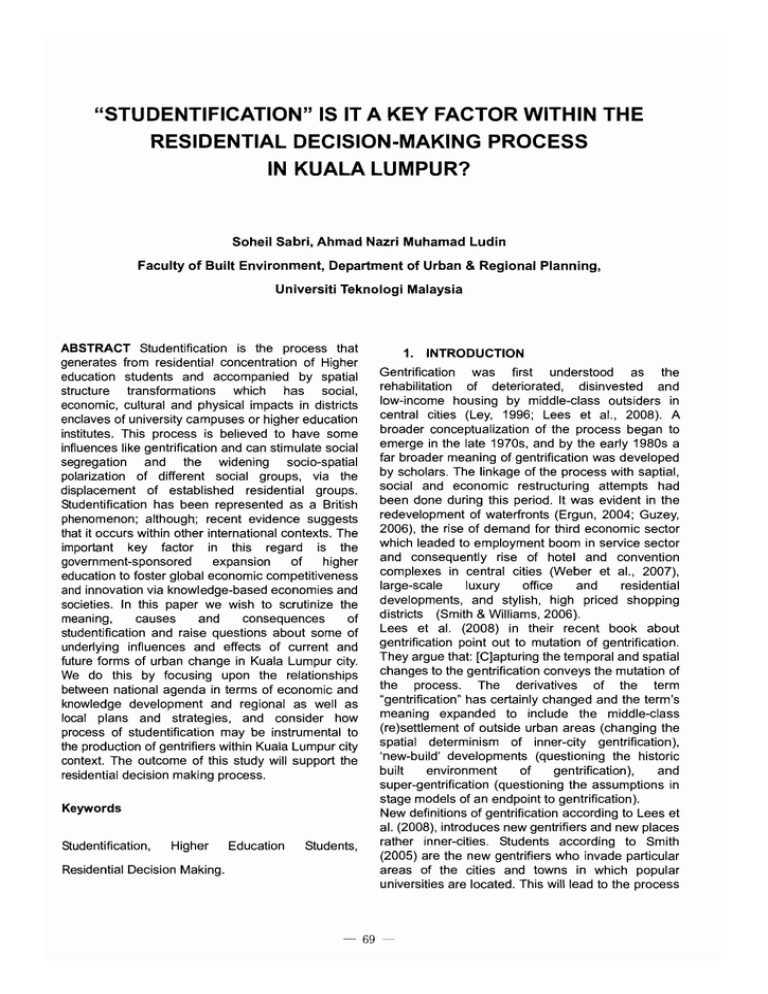
"STUDENTIFICATION" IS IT A KEY FACTOR WITHIN THE
RESIDENTIAL DECISION-MAKING PROCESS
IN KUALA LUMPUR?
Soheil Sabri, Ahmad Nazri Muhamad Ludin
Faculty of Built Environment, Department of Urban & Regional Planning,
Universiti Teknologi Malaysia
ABSTRACT Studentification is the process that
generates from residential concentration of Higher
education students and accompanied by spatial
structure transformations which has social,
economic, cultural and physical impacts in districts
enclaves of university campuses or higher education
institutes. This process is believed to have some
influences like gentrification and can stimulate social
segregation and the widening socio-spatial
polarization of different social groups, via the
displacement of established residential groups.
Studentification has been represented as a BritiSh
phenomenon; although; recent evidence suggests
that it occurs within other international contexts. The
important key factor in this regard is the
government-sponsored
expansion
of
higher
education to foster global economic competitiveness
and innovation via knowledge-based economies and
societies. In this paper we wish to scrutinize the
meaning,
causes
and
consequences
of
studentification and raise questions about some of
underlying influences and effects of current and
future forms of urban change in Kuala Lumpur city.
We do this by focusing upon the relationships
between national agenda in terms of economic and
knowledge development and regional as well as
local plans and strategies, and consider how
process of studentification may be instrumental to
the production of gentrifiers within Kuala Lumpur city
context. The outcome of this study will support the
residential decision making process.
Keywords
Studentification,
Higher
Education
Students,
Residential Decision Making.
-
1.
INTRODUCTION
Gentrification was first understood as the
rehabilitation of deteriorated, disinvested and
low-income housing by middle-class outsiders in
central cities (Ley, 1996; Lees et aI., 2008). A
broader conceptualization of the process began to
emerge in the late 1970s, and by the early 1980s a
far broader meaning of gentrification was developed
by scholars. The linkage of the process with saptial,
social and economic restructuring attempts had
been done during this period. It was evident in the
redevelopment of waterfronts (Ergun, 2004; Guzey,
2006), the rise of demand for third economic sector
which leaded to employment boom in service sector
and consequently rise of hotel and convention
complexes in central cities (Weber et aI., 2007),
large-scale
luxury
office
and
residential
developments, and stylish, high priced shopping
districts (Smith & Williams, 2006).
Lees et al. (2008) in their recent book about
gentrification point out to mutation of gentrification.
They argue that: [Gjapturing the temporal and spatial
changes to the gentrification conveys the mutation of
the process. The derivatives of the term
"gentrification" has certainly changed and the term's
meaning expanded to include the middle-class
(re)settlement of outside urban areas (changing the
spatial determinism of inner-city gentrification),
'new-build' developments (questioning the historic
built
environment
of
gentrification),
and
super-gentrification (questioning the assumptions in
stage models of an endpoint to gentrification).
New definitions of gentrification according to Lees et
al. (2008), introduces new gentrifiers and new places
rather inner-cities. Students according to Smith
(2005) are the new gentrifiers who invade particular
areas of the cities and towns in which popular
universities are located. This will lead to the process
69-
of social, environmental, and economic change that
is named as "Studentification". The process like
gentrification originated in Britain, but it has also
recently adopted in American English to refer to
similar problems arising from the overpopulation of
many U.S. 'college towns'.
It is assumed that such processes can be seen even
in second tier cities and or the cities in developing
countries that desire to follow the global
restructurings in terms of economy, politic and
culture. This is the motivation of the current research
on studentification in developing countries. We are
going to search for the exact meaning, cause and
consequences of process and evaluate whether it
can be a considerable issue in city like Kuala Lumpur.
The appraisal of phenomenon through literature and
future plans certainly can support our future work on
modeling and simulation of the residential dynamics,
which needs to focus on dominant residential groups
and categories in order to better figure out the future
social, economic and spatial structure of the areas.
The rest of this paper is divided into four sections. In
following section the meaning of "studentification" is
outlined. Its impacts from different points of view are
highlighted. In sections 3 and 4 the Malaysia
National plans and agenda as well as Kuala Lumpur
structural plan 2020 are studied to find the evidence
of studentification in contemporary state or in future
situation of the study area. The final section
suggests thinking and anticipating of the
studentification in spatial structure of Kuala Lumpur
city and considering its significance in residential
decision making process.
2. STUDENTIFICATION
Studentification is associated with seasonal,
in-migration of higher education (HE) students often
generating a distinct social, cultural, economic and
physical transformation within university towns
(Smith D., 2005).
According to D Smith (2005) the Processes of
studentification imply urban changes which are tied
with commodification of 'single-family' or the
repackaging of existing private rented housing, by
small scale institutional actors (e.g. property owners,
investors and developers) to produce and supply
houses in multiple occupation (HMO) for HE
students.
He defines the process of studentification in the
same vein of gentrification that in the 1980s and
1990s, dramatic transformations associated with the
processes which have captured the interest of the
Britain media. The term "Studentification" was listed
in the top 100 new words of 2002 (BBS 2002), and
has seep into numerous national media articles.
Chrisafis (2000) described the effects of the process
in Leeds. She outlines the replacements of families
by students in past three years. The dramatic rise of
-
home prices which knocked first-time buyers out of
market. The shortage of children in the area caused
school closure. She also pointed out to the political
impacts such as electoral role-over which its
percentage in a studentified area is about 7 times
more than the average of other city wards.
There are cultural and social changes that are
outlined by Harris and McVeigh (2002), the
conversion of pubs to theme bars, which often close
during the time of returning the students to their
homes. The significant existence of fast-food
takeaways and off-licences selling cheap alchohol
which dominate the shopping streets, all are the
main aspects of studentified areas.
The four key dimensions of studentification by which
we can distinguish the process from the other urban
changes are as follow:
Economic:
studentification
involves
the
revalorization and inflation of property prices, the
seasonal demand for houses turnes the economy to
seasonal manner, which is vital for many small
shops. Similarly, employment too would be seasonal,
and much in part-time. Knock-on effects can be
investigated in high service costs, including policing,
environmental health, cleansing and so forth.
Insecurity is the other reason which means high
insurance premium, for property, contents, and
vehicles.
Social: Normally the transformation of population
in studentified areas means the influx of chattering
classes (from the universities) which will change the
balance and coherent feature of previous settlers.
The social impact of studentification happens when
loss of amenity and high house prices make a
considerable emigration. The loss of services such
as school closure can affect on failure of social
networks, the one that is a consequent of transient
population also. The owners are not occupiers
anymore; this is regarded as "Absenteesm" (UK
National HMO Lobby, 2005).
During term-time the evidences of Low-level
antisocial behavior, noise and minor vandalism are
common. This will be scrutinized in next section.
Cultural: The student presence is often supposed to
bring 'dynamism' to the area, but we cannot digress
from consequences like noise. The presence of a
mass group of young population can be the reason
for some areas to become the focus of a pub culture;
based on the student market, this then will attract
youth from all over the other areas. The 'night-time
economy' definitely annoys residents. The central
Headingley in Leeds on Friday and Saturday nights;
and on major sporting occasions (especially
international football) experiences this condition, the
pub clientele has several times spilled out during the
day, and brought traffic to a complete standstill (UK
National HMO Lobby, 2005) . The participatory
programs have not sound appearance in studentified
areas. And they play no part in public debate:
70-
studentified areas have lowest electoral turnout
(National HMO Lobby, 2005). The need for presence
of older active people to keep alive the area's past
history can not be provided. Certainly activists can
sustain the present community but this would be in
threat by a few numbers of them. Moreover, the
number of children- who are the community's future
is essential in these areas.
Physical: Mostly in affected areas no property is
immune from conversion to student accomodation,
not only mansions, semis and terraces, but also
shops, offices and even outhouses and garages.
Good quality buildings would be vandalized by poor
quality dormer additions, basement conversions,
and outward extensions. The fabric of the buildings
will be left to deteriorate, or patched up by cowboy
builders. Curtilages (gardens, yards), once the pride
of their owners, will left to run wild, or razed to the
ground, or concreted over. The incidence of burglary
has leads to installation of security grills over doors
and windows.
Fig. 1: One of studentified neighborhoods in
Cork, Ireland.
Environmental: The neglected feature of streets will
happen through lack of care which is more evidnt in
neigborhoods that residents don't feel the belonging
sense (Sabri & Mosharzadeh, 2005). D Smith (2005)
points out to litter and large-scale waste are strewn
over streets and cartilages. The misused and
abused rubbish bins and virtually collapsing of waste
recycling in studentified areas of Leeds are
complained by residents. The ubiquitous flyposting
and discards flyers can be easily investigated in
these settlements. The general neglect encourages
graffiti. The start of each academic year, as students
return, the streets are congested and it will be
remained so during term-time. Cleansing and
maintenance are blocked. Road surfaces (and
marketings) suffer erosion, especially as on-street
parking is frequently on-pavement- which obstructs
pavements for pedestrians, and breaks down kerbs
and verges.
Fig. 2: The ubiquitous flyposting in
Berkley, California
All the mentioned general impacts can normally
happen in studentified areas in all around the world
as nowadays its pace is traced in US college towns
(Iobbystudentif.htm, 2005). But the question is that
what is the main reason behind the vast orientation
towards the higher education? In line with
long-standing theorisation of gentrifiers production, it
can be argued that the promotion of HE (and thus
the increase of HE students) is closely connected to
reproduction
of post-industrial
service-based
socio-economies, and the dramatic rise in the total
number and percentage of the labour force with
higher educational qualifications
(Smith P. D.,
2005).
Post-industrial
nations
developed
participation in higher education as a new
establishment and ongoing agenda, and this is
linked to the professionalization of the occupational
and employement structures in metropolitan and
global cities.
The existence of a growing opportunity for HE
students highlights a braoder cultural and ideological
change within society about the view and situation of
higher education. One of considerable outcomes of
this transformation is individual and familial
middle-class attitudes and perceptions that an
important phase of the 'typical' lifecourse of
middle-class individuals and households involves
the movement away from the parental home to study
at a higher education institute.
Relating to theorisations of causes of gentrification,
this manifestation can bring a broad change in
gender relations and demographic patterns (Bounds
& Morris, 2006), lifestyle preferences and
reproductive orientations, such as postponment or
rejection of marriage, family formation and
child rearing (Smith P. D., 2005). These are called
"apprentice gentrifiers" (Smith & Holt, 2007) which is
going to extend the meaning of gentrification. Hence,
we are facing with a new significant process that can
produce gentrifiers whose behaviors as agents
should be considered (Jackson et aI., 2008),
especially in growing and developing areas that
-71-
have globalize-oriented plans for
(Denholm, 2006; chatterton, 2000).
3.
their
future
NATIONAL PLANS AND AGENDA
"Raising the Capacity for Knowledge and Innovation
and Nurturing a First-Class Mentality" this is the
second key trust identified in National Mission
2006-2020 (NM) of Malaysia. Putting emphasize on
knowledge-based economy as the key determinant
of country's future success and raising the capacity
of its people by five strategies (Bruton, 2007) are the
main reasons that can be considered as stimulators
of new urban phenomena in city context of Malaysia
and especially in KL as the Capital city.
The five strategies are based on holistic human
capital development programme, comprehensive
improvement of the education system at three levels
(primary, secondary and tertiary), producing
universities of international aiming to fulfill the needs
of employees, encouraging top quality R&D,
science
and
innovation
environment
and
achievement of national growth and development by
empowering youth and women for their full
participation.
The Ninth Malaysia Plan 2006-2010 amplifies the
policies and key objectives of the NM's five main
trusts which the second one was outlined above, the
NM statement provide the basic structure for the
Ninth Malaysia Plan. Thus for the second thrust the
plan indicates that the country's human capital will
be developed in order to a transform to a
knowledge-based
economy.
lmropvement
of
education system will be achieved by new
programmes and projects. The enhance of tertiary
education quality to international standards,
nurturing top quality research and development,
scientific and innovation capability as well as
empowering the youth and women can be succeed
through the provision of more education and training
opportunities (Bruton, 2007).
In line with National Malaysia Mission 2006-2020
and Ninth Malaysia Plan 2006-2010, ministry of
higher education has visions and missions that can
notifies the evidence of emerging the new urban
phenomenon in terms of changing the urban feature
by higher education students and the related
functions: The ministry vision is " To Turn Malaysia
into a Center of Excellence for Higher Education"
this would determine the mission of ministry to
develop and put in place a higher education
environment that encourages the growth of premier
knowledge centers and individuals who are
competent, innovated with high moral values in order
to meet national and international needs. The
objectives which are defined based on the vision and
mission can further convey the significance of
-
anticipation for influx of higher education students
into cities in Malaysia and especially in Kuala
Lumpur that most of state and private higher
education institutes are located inside or in the
periphery areas of Kuala Lumpur City.
Internationalization as well as democratizing higher
education and producing sufficient graduates to
meet the countries manpower requirements are the
main aspects of these objectives. The higher
education capacity in Malaysia has grown from the
formation of the country's first university, Universiti
Malaya in 1961, to the 2007 enrolment of 942,200
students in 20 public universities, 32 private
universities and university colleges, four branch
campuses
of
international
universities,
21
polytechnics, 37 public community colleges, and 485
private colleges (Ministry Of Higher Education, 2007).
The
long-term Strategic Plan
of Ministry
encompasses four phases. The fourth phase is more
ambition and depends on the first three phases
which are going to be implemented up to 2020.
Figure 3 illustrates the transformation trend of
objectives, trusts and strategies.
1: uy1n1lM
FCNMlliof'l
. Pha..eo 1: St,.nctt-IrioI...-.d
EnMnctf'lWflt
Pha",); be-lI.rte.
:
rJ~~!~=:2~--=~.·.~~~~==>
I a1l'lC.M.~r.DfO,i
:=2=::~=-=C:=> ;
\
llttIVEUlGUUULMCf')
Il.n.-CJ
i
;'T<>lJo:"d~.'lldIrt~r"~t1Idei
"1l;cypo,;dI1s
(')(~c.iJt~d I.:PQrl
-HEI,' ,lIUetic: 1'\&'" ,l..,,-:-dlo
rran5ft)f",.lJ(ln~an
·j(('jinlt~IT"e:sfDrl"'.ul.-.tIl':ll:Md
~IlU!lC~""j
.EnW!org~nu·ol~.
Ul'li...n,it~
;.2HfJ,intt4l-H)QVK:lfk1
,~
.·)Hi::I~jnt(lplOOwor\d
1
.. 6 fl:iM'arc:h unilo'll:!n;t~~
·'0Pl"omt~~R&f).<.entr"
fA l!'(Ol'H~
_100 ~ l,1ternat,tom.t
K~U. Ql,ial1ty dri'R'tl
!1f'j., ~"""
;'1Qta\I...
....._l',.
.
'~
rl\l'\~li1f
{ .. '00 R.stI/UJ,OOO
wor"~c
'.2Hf11lntop5iOwond
: rri"-.
!.. Malapl&n tiobc'l.llN~.ll"1
'Mal.lI~~tnAy
'-jl):l,OOOPtl.D,bY2(JU
.lnllQ¥ltl~ !f~ob.Il p"odul.l~
'.
~:a~tr(l\l'll\1
aM ~~~ bf,totd on loc:..( ,
RF,C
a Respected r~(tr.JrY of
;, >;."'.
~_"""""', k",\(;",•. "'"
f)'tf~jo,,'>
'd~tf(1C pat~i
Fig. 3: The transformation Roadmap of Higher
Education in Malaysia. Source: (Ministry Of Higher
Education, 2007)
Noteworthy, the number of international students will
rise to 100,000 in second phase which is known as
"Strengthening and Enhancement". Moreover, in
phase three "Excellence" the division of Researchers,
Scientists and Engineers in workforce that should be
1001 10,000 along with 100,000 Ph.D by 2023 can
outline the future trend of the Malaysia towards a
developed country and consequently the new urban
phenomena like Studentification, Gentrification and
so forth. Malaysia began welcoming foreign students
in the early 1980s, but the rapid increase indicates
the enrolment of 66,000 international students in the
country's schools and universities. This comprised of
about 14,000 in public universities and more than
33,600 in private universities. The top five sources
for international students in Malaysia are: Indonesia,
China, Iran, Nigeria and Bangladesh (Insider, 2008).
72-
4.
LOCAL PLANS AND CONTEMPORARY
o
SITUATION IN KUALA LUMPUR
Looking at finer scale plans like Kuala Lumpur
Structural Plan 2020, The city is proposed as the
premier city and the capital of a nation with a highly
trade oriented economy that aspires to be fully
developed by the year 2020, city's vision, goals,
functions and growth directed towards a national and
the broader global perspective (CHKL, 2004). The
aim of "Knowledge-Based Economy" (K-economy) in
addition to the globalization trend, is one of key
factors in KLSP 2020, especially those are relating to
the development of information and technology (ICT).
Moreover, industries that generate knowledge such
as research and development in biotechnology,
computer science and related industries are
encouraged in this plan.
The development of Multimedia Super Corridor
(MSC) which is a corridor with 50 * 15 kilometers is
another influential plan in the process of attracting
the higher education students to this area. Although
the MSC corridor emphasizes on the R&D centre for
academic institution and corporate research and
development in Tele-suburb as one of its six main
centers (CHKL, 2004; Bruton, 2007), but there can
be anticipated that the shadow of such service
sections can be seen in inner parts of city. The
reason is that the scope of successful development
of the MSC is likely to meet a significant increase in
the job growth within Kuala Lumpur and faster
migration rate of foreigners especially those with
specialized skills.
Noteworthy, there are policies and strategies in
different parts points of view as economic, social and
quality of life that convey the integration of education
in variety of diciplines in future of Kuala Lumpur city:
D
D
D
D
D
D
D
of high technology and knowledge-based
industries.
H020:CHKL shall implement measures to
increase the number of medium and high
cost residential units in the City Centre.
(CHKL, 2004)
Looking at contemporary situation of education in
Kuala Lumpur can highlight the importance of Higher
education role in this City. According to a desck top
study about 100 University and HE institutes are
located in Kuala Lumpur city. These are comprised
of 3 public universities, 7 private universities and 90
private colleges. Table 1 shows the distribution of
these institutes based on six strategic zones that are
defined in KLSP 2020.
The critical situation of City Centre zone of Kuala
Lumpur is obvious regarding to locating the most
institutes in this zone 51%. Damansara-Penchala
zone that comprised of Universiti Malaya, the first
public university in country, has 17% of all higher
education institutes same as Wangsa Maju-Maluri
zone. But the distribution in the other three zones
are almost same and considerably lower than the
first three mentioned zones.
[EC1]: CHKL shall implement measures to
develop Kuala Lumpur as a centre of the
Knowledge-Based Economy.
EC7: CHKL shall encourage, promote and
facilitate the development of education and
health as commercial services.
EC8: CHKL shall facilitate the restructuring
and sustenance of the manufacturing sector
in favor of Knowledge-based and high skills
industries.
EC10: CHKL shall implement measures to
attract more people to live in the City Centre.
C03: CHKL shall permit K-Economy
activities in residential premises
TOlO: CHKL shall, together with the Kuala
Lumpur Tourism Action Counciland medical
and educational organisations, develop and
promote educational
and
health-care
tourism.
IN1: CHKL shall encourage the development
-
Table 1: Distribution of Higher education institutes in
Kuala Lumpur
Strategic Zone
City Centre
Wangsa Maju-Maluri
Sentul-Menjalara
Damansara-Penchala
Bukit Jalil-Seputeh
BandarTun
Razak-Sungai Besi
Total
Source: Authors, 2008
Number of HE
institutes
51
17
4
17
5
6
100
Furthermore, there are 186 HE institutes in periphery
areas around Kuala Lumpur that can have signifanct
impacts on the city. These are comprised of 4 public
universities, 2 polytechnics, 1 technical and
vocational, 4 government support colleges, 20
private universities, 2 foreign univeristies and 153
Private colleges.
The social impacts of international students in Kuala
Lumpur seems to be more significant aspect of
studentification. Sen (2008) mentioned the residents'
complaints about foreigners misbehaving and being
nuisance in the city. In one action the immigration
enforcement officers detained 15 Africans which
most of them were students from private institutions.
There have been some complaints in Wangsa Maju
and Cheras area by residents that mostly points out
to cultural and social impacts of foreign students.
73-
based on national and local plans. The City Center
has a critical situation in this regard that should be
taken into consideration in finer scale plans.
There is a strong need for further studies about
social transformation of cities based on current plans
and agenda which can feed up the decision-making
process.
Number of
HE Institutes
,
~J4
~n~}1iJ 5
IIllI ,
II1II17
II1II51
00,51
2
3
4
Kilometer"!;
Fig. 4: The distribution of HE Institutes in
Kuala Lumpur city
5. CONCLUSION
The essence of reviewing the "studentification"
process is outlined in this paper. The causes and
consequences of studentification phenomenon in it's
original location was explored. This is what
considered in recent gentrification studies and
regarded as part of mutation in gentrification process
(Smith & Holt, 2007; Lees et aI., 2008; Jackson et aI.,
2008). There are a few research in other countries
especialy in developing countries that are conducted
on such a new urban phenomenon. The global
competition of the cities (Guzey, 2006) and the new
urban ideologies such as smart growth and compact
city concepts (Sabri & Yakuup, 2008 a) make us to
anticipate the future spatial structure based on
agenda and plans and current trend of urban
developments.
The evidence of studentification impact on Kuala
Lumpur city was also outlined in this desktop study.
Moreover, the critical role of City Center as one of 6
strategic zones that consisted of 51 % of Kuala
Lumpur city and 10% of country's HE institutes was
highlighted.
In conclude, the studentification as new urban
phenomenon should be considered in college towns
as well as the urban areas that are in pace of
globalization. The process definitely has influences
in urban spatial structure so the consequences
should
be
anticipated
in
the
residential
decision-making process of the cities.
Kuala Lumpur is anticipated to face with influx of
higher education students and young profesionals
-
REFERENCES
Bounds, M., & Morris, A. (2006). Second wave
gentrification in inner-city Sydney. Cities , 23,
99-108.
Bruton, M. J. (2007). Malaysia The Planning Of a
Nation. Malyasia: PERSADA.
chatterton, P. (2000). The cultural role of universities
in
the
community:
revisiting
the
university-community debate. Environment and
Planning A , 32, 165-181.
CHKL. (2004). Kuala Lumpur Structure Plan 2020.
Kuala Lumpur: City Hall Kuala Lumpur.
Chrisafis, A. (2000, Oct 24). Two square miles of
housing hell. Retrieved Oct 27, 2008, from
guardian.co.uk:
http://www.guardian.co.uk/uk/2000/0cU24/angelique
chrisafis
Denholm, J. (2006). 'Studentification': a guid to
opportunities, challenges and practice. London:
Universities UK .
Ergun, N. (2004). Gentrification in Istanbul. Cities,
21,391-405.
Guzey, O. (2006). Understanding the logic of
Gentrification in different Geographies: a comparison
of five regeneration projects in Ankara Turkey. 42nd
ISoCarp (pp. 1-13). Ankara: Turkey.
Harris, P., & McVeigh, 1. (2002, July 21). Student
take over alarms cities. Retrieved Oct 27,2008, from
guardian.co.uk: http://www.guardian.co.uk
Insider, 1. M. (2008, November 29). Multicultural
Malaysia a hit with foreign students. Retrieved
December 10, 2008, from The Malaysian Insider:
http://www.themalaysianinsider.com
Jackson, J., Forest, B., & Sengupta, R. (2008).
Agent-Based SimUlation of Urban Residential
Dynamics and Land Rent Changing in a Gentrifying
Area of Boston. Transactions in GIS , 12(4),
475-491.
Lees, L., Slater, T., & Wyly, E. (2008). Gentrification.
New York: Routledge.
Ley, D. (1996). The New Middle Class and the
Remaking of the Central City. New York: Oxford
University Press.
Ministry Of Higher Education, M. (2007). National
Higher Education Action Plan 2007-2010. Ministry Of
Higher Education, Malaysia.
Sabri, S., & Mosharzadeh, Z. (2005). In search of
Identity in new Towns. International conference on
development of new Towns, Tehran, Iran. Tehran:
Building and development corporation of new towns,
74-
ministery of housing and development.
Sabri, S., & Yakuup, A. (2008 a). Multi-Criteria
decision making for urban sprawl, using Analytic
Network Process and GIS, Case of Iskandar
Malaysia Region. Map Asia 2008. Kuala Lumpur:
GIS Development.
Sen, 1. E. (2008, November 28). Loitering Foreign
students detained. Retrieved December 10, 2008,
from
Malay
Mail
Your
voice:
http://www.mmail.com.my
Smith, D. P. (2005). "Studentification": The
Gentrification factory? In R. Atkinson, & G. Bridge,
Gentrification in a Global Context, the new urban
colonialism (pp. 72-89). Oxon: Routledge.
Smith, D. P, & Holt, L. (2007). Studentification and
'apprentice' gentrifiers within Britain's provincial
towns and cities: extending the meaning of
gentrification. Environment and Planning A , 39,
142-161.
Smith, N., & Williams, P (2006). Gentrification of the
City. Routledge Chapman & Hall.
UK National HMO Lobby. (2005, February).
Retrieved October 25, 2008, from hmolobby.org.uk:
http://hmolobby.org.uk/lobbystudentif.htm
Weber, R., Bhatta, S. D., & Merriman, D. (2007).
Spillovers from tax increment financing districts:
Implications for housing price appreciation. Regional
Science and Urban Economics, 37,259-281.
-
Ahmad Nazri Muhamad Ludin
received the Adv. Diploma in
Urban & Regional Planning
(1984) from UiTM, Malaysia. He
then received the MSc. In Applied
Remote Sensing (1989) and PhD.
(1998) from BristOl University, UK.
He is an Assoc. Professor at The
Depart. Of Urban & Regional
Planning, UTM. His research
interest include the application of
Remote Sensing and GIS in
urban & regional planning
e-mail:
b-anazri@utm.my
Soheil Sabri received the B.Sc.
(1996), M.Sc. (2004) From
Tehran Azad University, Science
and Research Campus. He is
PhD. Student, in Department of
Urban & Regional Planning.
Faculty of Built Environment.
Universiti Teknologi Malaysia.
His current research topic is "An
Integrated Geosimulation and
Analytic Network Process of
Gentrification in Kuala Lumpur
city"
e-mail:soheilsabri@gmail.com
HIP: +6012 779802
75-
